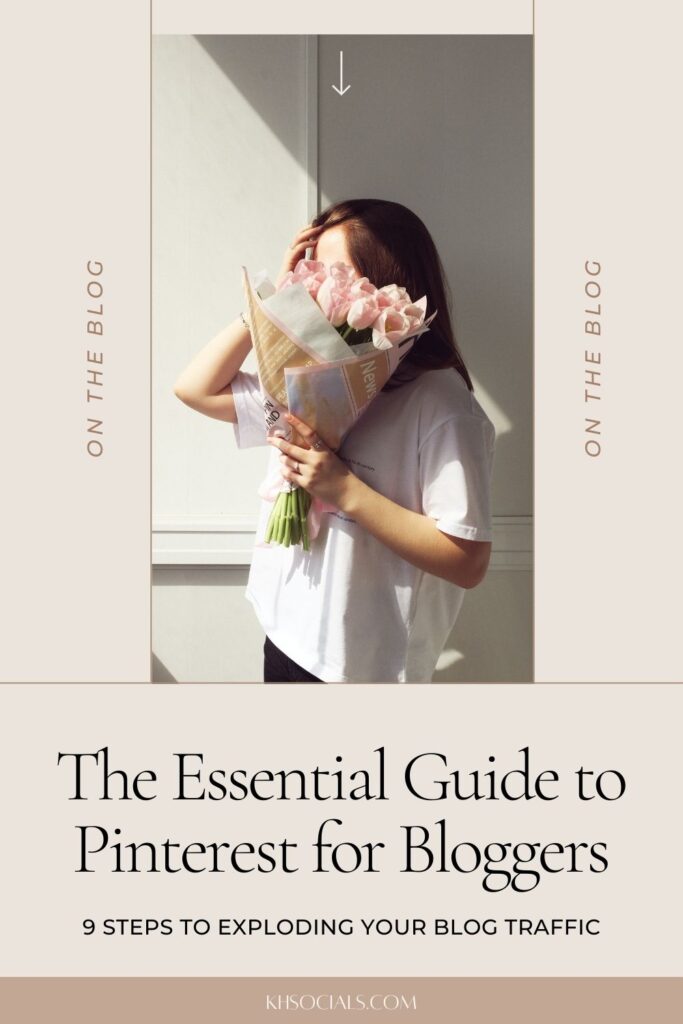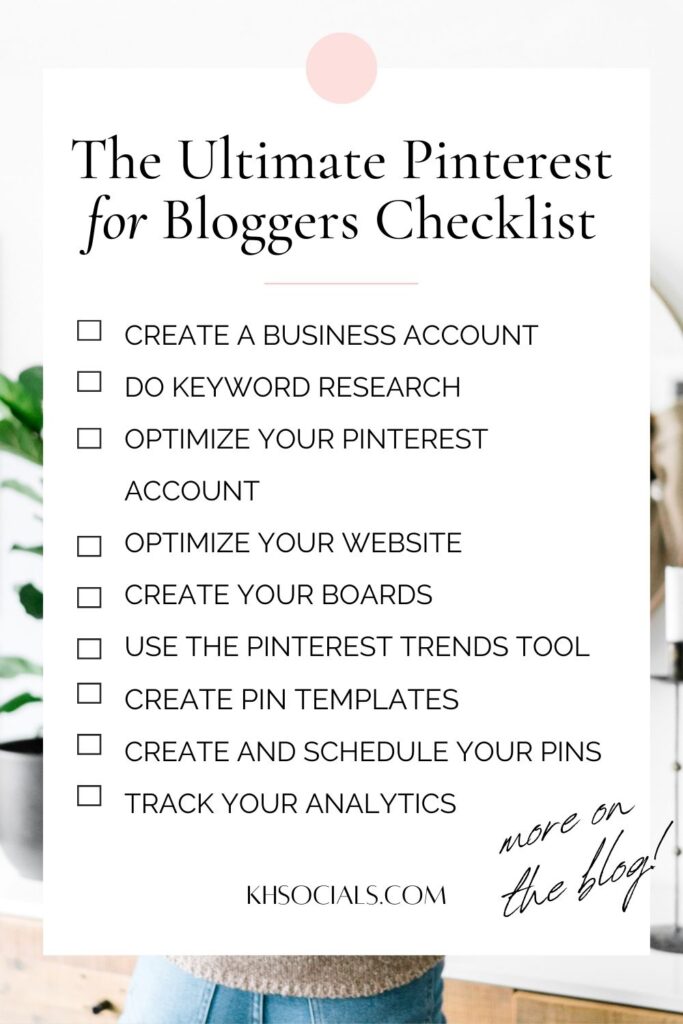Pinterest marketing for bloggers
Last week, we talked all about the benefits of using Pinterest for bloggers and why Pinterest is the perfect platform for promoting and growing your blog.
If you haven’t read that post yet, check it out here– it gives a lot of insight into how the platform works and explains why it’s such an essential platform for bloggers.
Today though, we’re getting into the nitty gritty and talking about exactly how you can use Pinterest marketing to grow your blog and explode your website traffic and readership.
Pinterest marketing is rocket fuel for bloggers’ website traffic and promoting your blog on Pinterest is an absolute game changer.

In this post, I’m going to walk you step-by-step through everything you need to do to make and grow your blog on Pinterest. Let’s get into it! 💃
1. Create a business account
To take advantage of all of Pinterest’s business features (ex. claiming your website, tracking your analytics, etc.), you’ll need a Pinterest business account, not a personal account. You can convert your current personal account to a business account, but I typically recommend starting a new business account and keeping things seperate.
2. Do your keyword research
Because Pinterest is a search engine, good SEO and keyword research is essential to getting your content discovered. Pinterest keyword research isn’t difficult, but you do need to be thorough. I go in depth on how to do keyword research here and where to user your keywords here.
When you’re deciding what topics you need to find keywords for, start by looking at the main categories you cover. If you’re a lifestyle blogger, for example, you might cover a variety of topics like fitness, home decor, recipes, and fashion. Do general keyword research for each of these topics.
Then you can start to niche down. Within each category, you likely have sub-topics you cover, for example, Pilates, neutral home decor, vegetarian recipes, and athleisure outfits. Pick out your main sub topics and do keyword research for these topics.
I like to get a solid bank of keywords for both my main topics and sub topics to begin with. Then I’ll do a quick keyword search for each specific blog post.
For example, if you share a lot of athleisure content, you’ll have your general keywords for this. Then say you write a post about how to style bike shorts- this is pretty niche, so you probably haven’t done previous keywords for this, so just do a quick search for bike shorts keywords and use these for those specific Pins.
Basically: general keyword research upfront, blog posts specific research as you go.
Want all of the insider tips on running a successful Pinterest account? Grab our FREE Beginner’s Guide to Pinterest Marketing.
3. Optimize your account
Now that you have your keywords, it’s time to start optimizing your account! Your Pinterest account isn’t as important as your Instagram account because Pinterest users will more so be engaging with your individual Pins in the feed rather than scrolling through your account like they do on IG, but it’s still really important to get it set up properly a) for SEO purposes, and b) to connect with your ideal audience/reader.
Go through the following steps to ensure that your account is properly set up and optimized.
- Claim your website. This allows you to track all of the analytics from Pinterest to your website, including Pins that others Pin from your site.
- Write a keyword rich Pinterest name and account bio. This will help you show up in searches and tell your ideal audience what you’re all about. For bloggers, I like including an IG handle in your bio to encourage users to follow you there as well.
- Add a profile and cover image. Showcase your blog’s vibe and focus with great visuals! For the profile image, I typically recommend a photo of you or your logo, and for the cover image, I recommend a photo/collage/video of you and/or the things you blog about (ex. your recipes, outfit styling, travel photo, yoga shot, etc.). This is the place to be creative and showcase your brand!
4. Optimize your website for Pinterest traffic
This is a mistake I see SO MANY bloggers make, and I hate it!! If you’re not optimizing your blog to encourage others to Pin your content, you’re missing out on MAJOR Pinterest traffic.
There are two ways to get traffic from Pinterest: 1.) you Pin your own content and others engage with it, and 2.) others come to your website and Pin it.
Both are super important. The content you Pins is under your control, but the content others pin tends to get a wider reach.
Think of it this way: when you Pin your own content, you’re saying to Pinterest “this is valuable!” but this hold a little less weight to Pinterest because, well, of course you think it’s valuable, but do others?
When someone else comes to your website and Pins something, it indicates to Pinterest that this is actually really valuable because others think so.
I wrote a whole post on how to optimize your website for Pinterest traffic here. Do not skip this step! It’s basically free marketing.
Repeat after me: “I will optimize my blog for Pinterest traffic!”
5. Create your boards
Your boards are where your Pins will “live,” and you want to create at least one board for every topic and sub-topic you cover. To avoid overwhelm, I recommend starting off with 7-10 boards and adding as you go.
Say you’re a travel blogger and you focus on European travel guides. You’ll make boards for “Europe Travel,” specific regions like “Mediterranean travel,” boards for each country you cover, and then if you have a lot of content about a specific city/area, make boards for them.
Then if you include other content like travel hacks, travel tips, budget travel advice, etc. create boards for these.
As you go, you may find that a couple of topics really take off, so you can create more boards for this specific topic using a slightly different keyword.
One of the biggest mistakes I see is people creating boards with cute names that have no SEO benefit. Remember, keyboarding is essential on Pinterest, and anywhere you’re using text, you should be using keywords. For example, instead of a board called “Wanderlust,” call it “Travel Tips”
6. Use the Pinterest Trends tool
I LOVE the Pinterest trends tool, and I really don’t think it gets enough attention. The trends tool is important for two reasons: 1) it lets you see when different topics are trending on Pinterest so you can plan your content and Pin scheduling accordingly, and 2) it shows you what topics are trending in your niche, which can help to inform the content you create.
For some bloggers, your content is more evergreen, so seasonal trends aren’t as relevant, but for many of you, seasonal content is huge and knowing when your audience is searching for these topics is a major advantage.
Use the Trends tool to search your main topics and sub topics to see when they’re trending throughout the year, and aim to Pin this content 1-2 months before the trend peaks to give the algorithm time to index and distribute the content.
7. Create Pin templates
Pinterest requires a consistent supply of content, and the best (and really only) way to provide this is to create multiple pins for each piece of content (ex. blog post) that you create. By creating a set of 5-7 Pin templates, you can customize these for each blog post and easily create lots of Pins per post.
Canva has lots of free template options, or you can purchase a template pack on Creative Market or Etsy, or start from scratch and create your own!
In addition to Pin templates, you should also Pin all of your images and experiment with Video Pins.
8. Create and schedule your Pins
Okay, your account is optimized, you’ve nailed your keyword research, your Pin templates are ready to go and it’s FINALLY time to start creating and scheduling your Pins!! Best practice is pinning between 3-10 Pins/day, so the best way to do this is with a scheduling tool like Tailwind.
For each piece of content you create, you can create anywhere from 5-10 Pins and then schedule them out to all relevant boards.
Prioritize pinning your new content as well as creating new Pins for old content that is currently trending. For example, if you’re a fashion blogger, re-Pin past outfit posts that did really well the last season, ex. Spring Athleisure Outfit Ideas, Best Holiday dresses, etc.
Pinterest puts a huge emphasis on sharing fresh content, but re-sharing past content that performed really well is still a great way to get serious engagement.
9. Track your analytics
Pinterest offers a fairly robust analytics platform, and this is super helpful for tracking your results and seeing what is/isbn’t working.
I like to go in and take a look at analytics monthly- because Pinterest is a slow moving platform, looking anymore often than that isn’t overly helpful. It takes time for content in Pinterest to index and distribute new content, so we need to give it time to do it’s thing.
Primarily in analytics, we’re primarily looking at
Impressions: This is how often your content has been seen and is a good indicator that your keyboarding is good and that Pinterest see your content as valuable enough to distribute.
Saves: The number of times someone saves your Pin to their board. This is a great indicator that people see value in your content and plan to revisit in the future.
Engagement: The number of times someone has engaged with your Pins.
Outbound clicks: The most important number! This is the number of times someone has clicked from your Pins to your website.
Then I also like to look at which Boards and which Pins are getting the most engagement. This will tell you what people are really loving and it can help to inform your content strategy moving forward.
So that is how you you grow your website traffic with Pinterest! Pinterest is a slow moving platform, so it’s not likely to explode your traffic overnight (although for some accounts it does work really quickly), but with consistent Pinning and a solid strategy in place, you can see tens of thousands of impressions per month roll in.
Blogging and Pinterest are truly a match made in heaven, and by following these steps, you’ll be ready to reap all of the benefits that the platform has to offer! So get out there and get that website traffic- you’ve got this!
Ready to explode your blog traffic without any of the heavy lifting? Check out my Services page to see how we can work together!
PIN IT FOR LATER

The Ultimate Guide to Pinterest Marketing for Bloggers
VIEW THE COMMENTS